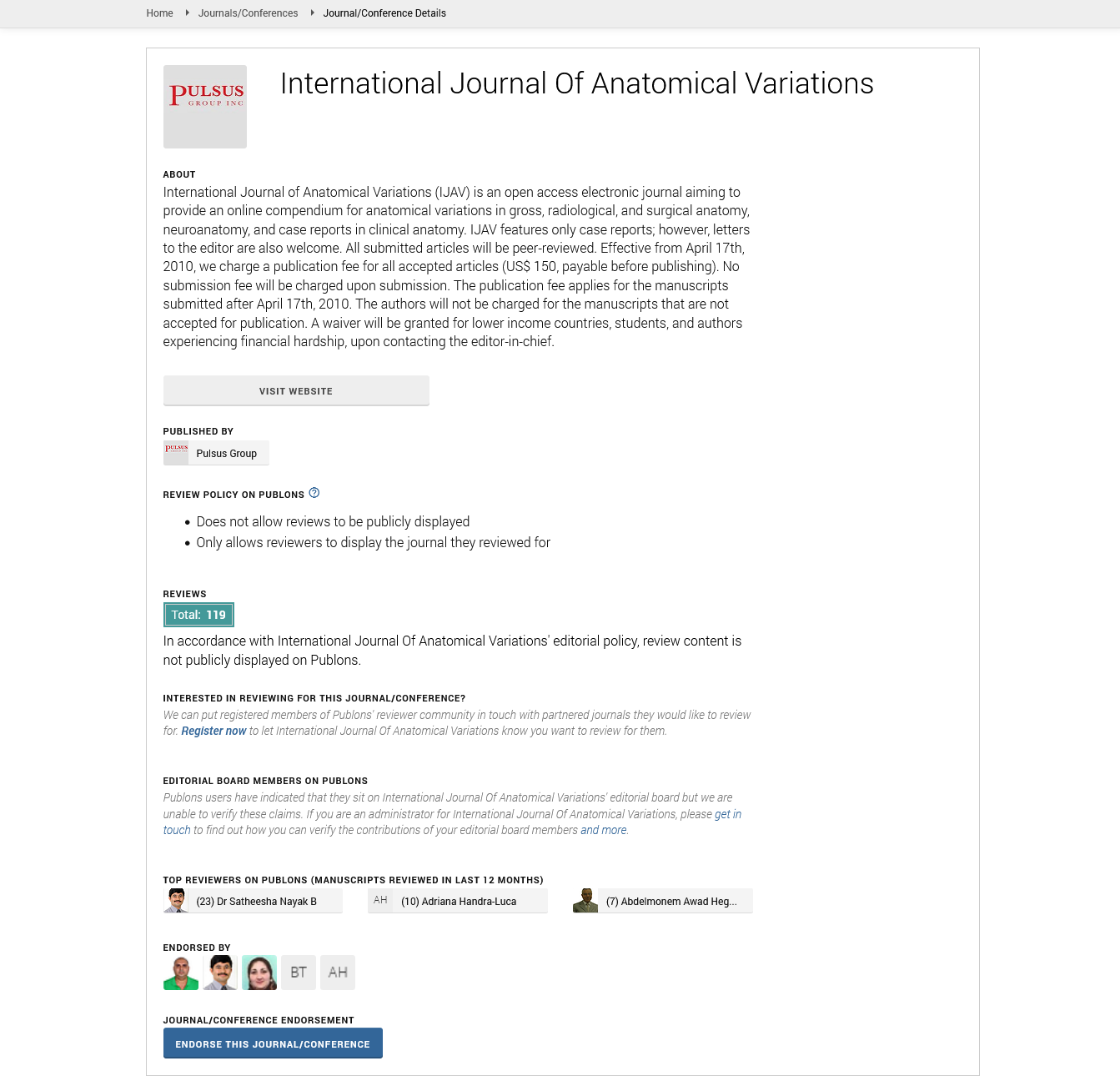Rare Vascular Anomalies in the Brain: Implications for Stroke and Neurosurgical Interventions
Received: 02-Dec-2024, Manuscript No. ijav-24-7359; Editor assigned: 04-Dec-2024, Pre QC No. ijav-24-7359 (PQ); Reviewed: 18-Dec-2024 QC No. ijav-24-7359; Revised: 26-Dec-2024, Manuscript No. ijav-24-7359 (R); Published: 31-Dec-2024, DOI: 10.37532/1308-4038.17(12).466
Citation: Takahashi S. Rare Vascular Anomalies in the Brain Implications for Stroke and Neurosurgical Interventions. Int J Anat Var. 2024;17(12): 701-702.
This open-access article is distributed under the terms of the Creative Commons Attribution Non-Commercial License (CC BY-NC) (http://creativecommons.org/licenses/by-nc/4.0/), which permits reuse, distribution and reproduction of the article, provided that the original work is properly cited and the reuse is restricted to noncommercial purposes. For commercial reuse, contact reprints@pulsus.com
Abstract
Vascular anomalies in the brain, though rare, can lead to severe neurological complications such as stroke, hemorrhage, and seizures. These anomalies, including arteriovenous malformations (AVMs), cavernous malformations (CMs), brain aneurysms, dural arteriovenous fistulas (DAVFs), and capillary telangiectasia, can be congenital and present significant challenges for both diagnosis and management. AVMs and brain aneurysms, in particular, pose risks of rupture and hemorrhagic stroke, requiring prompt surgical or endovascular intervention. Cavernous malformations and DAVFs may lead to neurological deficits or seizures, while capillary telangiectasias are often asymptomatic but can cause localized bleeding. Accurate diagnosis through advanced imaging is essential, as these anomalies may mimic other neurological conditions, complicating stroke management. Treatment options vary depending on the type, location, and severity of the anomaly, with surgical resection, embolization, and radiosurgery being common approaches. Early identification and tailored interventions are critical to improving patient outcomes in these complex cases.
INTRODUCTION
The Vascular anomalies in the brain are rare yet significant conditions that can lead to a variety of neurological complications, including stroke, hemorrhage, and seizures. These anomalies, which involve the blood vessels of the brain, can range from benign to life-threatening. Vascular abnormalities such as arteriovenous malformations (AVMs), cavernous malformations, and brain aneurysms are often present at birth, but symptoms may not manifest until later in life. Understanding these rare vascular anomalies is critical for neurosurgeons and neurologists, as their presence can profoundly impact the management of strokes and influence surgical decision-making. The implications of these anomalies for both acute stroke treatment and long-term neurovascular interventions are significant, as improper management can lead to severe neurological deficits or even death. This article explores the types of rare vascular anomalies in the brain, their clinical implications, and their role in stroke and neurosurgical interventions [1].
OVERVIEW OF VASCULAR ANOMALIES IN THE BRAIN
Vascular anomalies in the brain generally refer to abnormal structures within the cerebral vasculature. These anomalies can lead to compromised blood flow, rupture, or clot formation, which may subsequently cause stroke or other neurological events. Vascular anomalies can be classified into various types, including many of these conditions requires tailored approaches for treatment and may necessitate surgical intervention or other neurovascular therapies. The key challenge in managing these vascular anomalies lies in their rarity and the need for a precise diagnosis, particularly since their clinical presentation may be vague or mimic other neurological conditions [2].
TYPES OF RARE VASCULAR ANOMALIES IN THE BRAIN
Arteriovenous Malformations (AVMs)
AVMs are congenital vascular anomalies that result from the abnormal connection between arteries and veins without the presence of capillaries. This creates a high-flow system that bypasses the normal regulation of blood pressure, leading to increased risk of rupture and hemorrhagic stroke. AVMs can range in size and location, with some being asymptomatic until rupture occurs. Commonly, AVMs are found in the cerebral hemispheres, but they can also be located in other areas such as the brainstem and spinal cord. The primary concern with AVMs is their potential to rupture, which leads to significant bleeding in the brain, often resulting in a hemorrhagic stroke. Surgical resection, endovascular embolization, and stereotactic radiosurgery are all potential treatment options, but each comes with its own risks and benefits depending on the size, location, and complexity of the AVM [3]. The presence of an AVM can also complicate acute stroke management, as the vascular malformation may either contribute to a hemorrhagic stroke or exacerbate ischemic events.
Cavernous Malformations (CMs)
Cavernous malformations are clusters of abnormally dilated, thin-walled blood vessels that are prone to rupture, causing intracerebral hemorrhages. These malformations are typically congenital and are often discovered incidentally during imaging for unrelated issues. They are most commonly located in the brainstem, cerebellum, or cerebral cortex. CMs may present with focal neurological deficits, seizures, or headaches. Although many patients with CMs are asymptomatic, those who experience symptoms often present with sudden neurological deterioration due to bleeding or progressive neurological dysfunction [4]. Surgical resection is the treatment of choice for symptomatic CMs, but the location and deep-seated nature of these malformations can complicate the surgical approach, especially in the brainstem, where critical motor and sensory pathways are located.
Brain Aneurysms
Brain aneurysms are abnormal bulges in the walls of blood vessels within the brain that can rupture and lead to subarachnoid hemorrhage (SAH), a form of hemorrhagic stroke. The most common location for brain aneurysms is at the bifurcations of large arteries, particularly the anterior communicating artery, middle cerebral artery, and basilar artery. Aneurysms can be congenital or develop over time due to hypertension, atherosclerosis, or other vascular conditions. The rupture of an aneurysm leads to the sudden onset of a severe headache, which may be accompanied by loss of consciousness, nausea, and neurological deficits. Unruptured aneurysms are often asymptomatic but carry the risk of rupture at any time. Neurosurgical interventions, including microsurgical clipping and endovascular coiling, are employed to prevent rupture or treat ruptured aneurysms. Early identification and treatment are crucial in preventing further hemorrhagic strokes and reducing the risk of long-term neurological deficits [5].
Dural Arteriovenous Fistulas (DAVFs)
Dural arteriovenous fistulas are abnormal connections between arteries and veins within the dura mater. Unlike AVMs, DAVFs primarily involve the meningeal arteries, which supply blood to the dura and the outer part of the brain. DAVFs can cause venous hypertension, leading to cortical venous reflux, which may result in neurological deficits, seizures, or intracranial hemorrhage. While DAVFs are rare, they are of particular concern due to their potential to cause significant neurological symptoms or hemorrhagic stroke. Management typically involves endovascular embolization or, in some cases, surgical resection of the fistula [6]. DAVFs require careful assessment through imaging modalities like digital subtraction angiography (DSA) to determine the precise location and drainage pattern, which influences treatment decisions.
Capillary Telangiectasia
Capillary telangiectasia refers to a rare, small cluster of dilated capillaries that may be asymptomatic or cause localized bleeding. While generally considered benign, these vascular anomalies can occasionally cause neurological deficits or hemorrhage, especially when located in critical brain regions. Due to their small size, capillary telangiectasias are typically discovered incidentally during imaging, often as part of an evaluation for other conditions. When symptomatic, they may require intervention, but treatment options are limited due to the benign nature of the malformation. Surgical resection is not typically performed unless the condition results in significant neurological symptoms [7].
CLINICAL IMPLICATIONS FOR STROKE MANAGEMENT
Diagnosis of Stroke in the Presence of Vascular Anomalies
Diagnosing stroke in patients with underlying vascular anomalies can be challenging. These anomalies can mimic the symptoms of stroke, especially if they cause subclinical hemorrhages or transient ischemic events. Additionally, the risk of bleeding or rupture from vascular malformations can complicate stroke management, particularly in patients who present with hemorrhagic strokes. Advanced neuroimaging techniques, including high-resolution CT scans, MRIs, and angiography, are critical in differentiating between stroke caused by vascular anomalies and other causes of cerebrovascular events [8]. Identifying the presence and type of vascular anomaly is essential for guiding treatment, whether surgical, endovascular, or pharmacological.
Impact on Surgical Interventions
Surgical intervention for vascular anomalies in the brain is often required to prevent further bleeding or to treat existing neurological deficits. However, the location and size of the vascular anomaly significantly influence the choice of surgical approach. For instance, AVMs may require surgical resection, endovascular embolization, or stereotactic radiosurgery. Each treatment modality has different risks and benefits depending on the patient's specific anatomy. Cavernous malformations, located in deep brain structures, pose significant challenges for surgical resection due to the risk of damaging surrounding neural tissue. Neurosurgeons must carefully weigh the risks of surgical intervention against the potential for neurological improvement. Brain aneurysms may require microsurgical clipping or endovascular coiling, depending on their size, location, and rupture status. The management of aneurysms is highly time-sensitive, as the risk of rebleeding or ischemic complications is high in the immediate post-rupture period. In the case of DAVFs, endovascular embolization remains the treatment of choice, though surgical resection may be necessary in certain cases.
CONCLUSION
Rare vascular anomalies in the brain present significant challenges for stroke and neurosurgical interventions. Arteriovenous malformations, cavernous malformations, brain aneurysms, dural arteriovenous fistulas, and capillary telangiectasias can all have serious implications for both the acute management of stroke and the long-term neurological outcomes of patients. These anomalies can complicate the diagnosis and treatment of cerebrovascular events, and their presence requires careful surgical planning and intervention. Advanced imaging techniques are crucial for identifying these anomalies early, and tailored treatments, including microsurgical resection, endovascular embolization, and stereotactic radiosurgery, can offer significant benefits in managing these rare conditions. Further research into the genetic and molecular mechanisms of vascular anomalies will likely provide insights into better treatment options and improved patient outcomes.
REFERENCES
- Xin W, Bofu L. Aortic Dissection with Rare Anatomical Aortic Arch Variation Depicted by Computed Tomography Angiography. Heart Surg Forum. 2021; 24(2): E407-E408.
- Foivos I, Jonathon K, Daryll B. Aberrant right subclavian artery - a rare congenital anatomical variation causing dysphagia lusoria. Vasa. 2021; 504(5):394-397.
- Jun S, Zhang-Y, Chuan C. Postoperative neovascularization, cerebral hemodynamics, and clinical prognosis between combined and indirect bypass revascularization procedures in hemorrhagic moyamoya disease. Clin Neurol Neurosurg. 2021 Sep; 208:106869.
- Qi L, Xiaojie T, Yafang D. Evaluation of Carotid Plaque Rupture and Neovascularization by Contrast-Enhanced Ultrasound Imaging: an Exploratory Study Based on Histopathology. Transl Stroke Res. 2021 Feb; 12(1):49-56.
- Kuo-Shyang J, Shu-Sheng L, Chiung-FC. The Role of Endoglin in Hepatocellular Carcinoma. Int J Mol Sci. 2021 Mar 22;22(6):3208.
- Anri S, Masayoshi O, Shigeru H. Glomerular Neovascularization in Nondiabetic Renal Allograft Is Associated with Calcineurin Inhibitor Toxicity. Nephron. 2020; 144 Suppl 1:37-42.
- Mamikonyan VR, Pivin EA, Krakhmaleva DA. Mechanisms of corneal neovascularization and modern options for its suppression. Vestn Oftalmo. 2016; 132(4):81-87.
- Schizas N, Patris V, Lama N. Arc of Buhler: A lifesaving anatomic variation. A case report. J Vasc Bras. 2012; 37(11):9-326.
Indexed at, Google Scholar, Crossref
Indexed at, Google Scholar, Crossref
Indexed at, Google Scholar, Crossref
Indexed at, Google Scholar, Crossref
Indexed at, Google Scholar,, Crossref
Indexed at, Google Scholar, Crossref
Indexed at, Google Scholar, Crossref






